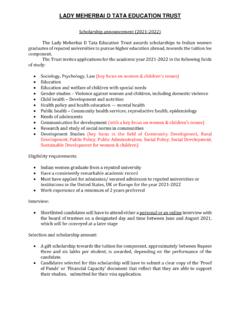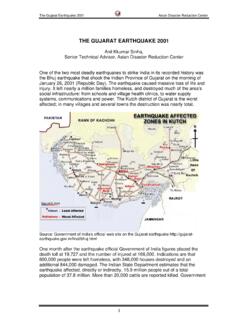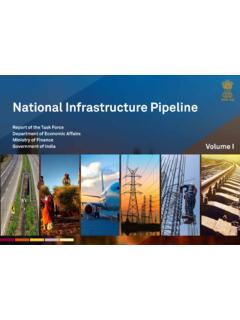Transcription of REPORT ON OLD AGE FACILITIES IN INDIA ... - Tata Trusts
1 REPORT ON OLD AGE FACILITIES IN INDIA BACKGROUND INDIA has been classified as an ageing country by the United Nations, with of the total population over 60 years of age. This number is expected to triple by 2050, thereby constituting 20% of the population. Changing socio-economic patterns, such as women becoming economically active and participating in the workforce, and increasing mobility are all leading to more nuclear households, altering social norms of elder care in the family. Despite the dire need, elder care in INDIA is still largely neglected and the development of the ecosystem is primitive1. Secondary research and practitioners from the sector estimate 600 to 1,700 operational FACILITIES for senior citizens in INDIA .
2 However, the research and data are not comprehensive enough to completely portray ground reality. This study by Tata Trusts , Samarth and United Nations Population Fund (UNPFA) took a fact-based approach to develop a reasonably robust estimate of available supply to help understand the nature and scale of challenge and the required capacity to support implementation of any framework that is adopted. SURVEY PROCESS The study looked at both old age homes and senior living developments in INDIA , built an extensive sample set of 480+ old age homes and 60+ senior living developments in 84 cities, towns and districts cutting across geographies, size, cost, FACILITIES offered, ownership and management.
3 It projected the sample set to countrywide population data extracted from 2011 census of INDIA , and arrived at an estimate of around 1,150 FACILITIES and the capacity to house around 97,000 elderly residents. Forecasting likely demand driven by increasing elderly population and change in preferences owing to availability of new products and socio-economic norms, the study pointed towards a crying need to enhance the capacity almost eight to ten-fold over the next decade. ESTIMATING SUPPLY OF OLD AGE HOMES Old age home listings published by Samarth including both urban and rural FACILITIES were used to prepare a sample of 532 old age homes across 84 towns and districts in INDIA .
4 These included all types of old age homes in terms of location, ownership, management, size and FACILITIES thus providing a rich cross-section and sample. The data on capacity and utilization was also collected. As part of this research, 60 operational senior living community projects were enumerated across INDIA . These had, in total, 12,695 units comprising of apartments, row houses, cottages and villas. 1 As per the data published by Helpage INDIA in 2009, in INDIA , there are 1,176 senior living FACILITIES in the country. Kerala had the highest number of senior living FACILITIES (182), whereas west bengal stands at the second position with 164 senior living FACILITIES , followed by Tamil Nadu (151), Maharashtra (133), Andhra Pradesh (114), Karnataka (91), and Gujarat (77).
5 Our sample validation found that since then, many of these FACILITIES have closed or are operating only in name. Assuming that 10% of the total capacity could not be enumerated for various reasons, and each unit contributing 2 beds, the estimated capacity in senior living communities adds up to 27,900. The total capacity across both types of senior living FACILITIES is, thus, estimated at 97,000 beds (rounded). DEMAND FORECAST IN FUTURE YEARS FOR SENIOR HOUSING FACILITIES Taking into account the drivers of future demand, this study estimated the demand for senior living FACILITIES over the next 10 years. For this purpose, data was analyzed for INDIA and 24 other countries with a wide range of economic development indicators and demand for senior living FACILITIES .
6 Correlation between GDP per capita in PPP terms and the number of beds per thousand elderly above 60 years of age indicates that the need for senior living may rise to around eight to ten lakh beds in the next 10 years, which is an eight to ten-fold increase over the current base implying a compounded increase of ~25 % annually each year. BASELINE OF STANDARDS AND PREVAILING NORMS The study looked at the experience of states as well as the norms and practices prevalent at the FACILITIES currently. The study included states/UTs such as Tamil Nadu, which has laid out basic minimum standards and norms in recent years, Madhya Pradesh and Daman interviews with experts, practitioners and government officials and visits to actual FACILITIES , to understand the experience and reasons behind the current situation.
7 Given the variety of FACILITIES present, the sample covered different types of FACILITIES including those in major cities like Delhi and Mumbai, old age homes in tier-2 cities like Coimbatore and Pune, old age homes for the destitute/lower-economic class, old age homes for middle-class and upper-middle class and senior living developments ranging from economy to luxury in different parts of INDIA . FINDINGS: Study revealed a yawning gap between expectations and delivery of services at most elder care FACILITIES Despite provisions in the National Policy, there is nothing substantial implemented to address elder care needs Senior Citizen Homes run by private organizations and charity homes only address the needs of a fraction.
8 There is no way of evaluating the quality and appropriateness of the services Not only does it leave elderly residents at these homes vulnerable, it also provides no incentive for the facility owners and managers to improve EMERGING STANDARDS AND IMPLEMENTATION FRAMEWORK FOR INDIA Based on global experience and best practices, discussions and inputs from experts in developed eldercare markets, consultations with experts and practitioners in INDIA as well as an understanding of the baseline, the study has identified 5 key result areas and 28 performance metrics which offer a set of comprehensive, measurable and practical standards. The study recommends that minimum standards should be made mandatory, and implemented through compulsory registration, annual filings and periodic inspections.
9 Certification for higher than mandatory ratings through an accreditation type process is recommended to be kept voluntary. This will ensure that while every facility meets the minimum standard, the cost of detailed certification and accreditation, however small, is not imposed on everyone. Higher ratings would help participating FACILITIES communicate their value proposition effectively and even be able to command a premium where desired. development OF DRAFT STANDARDS AND IMPLEMENTATION FRAMEWORK Data collected from the site visits coupled with expert interviews and study of benchmarks were used in the selection of design principles, to develop frameworks for implementation of standards.
10 Based on the desired outcomes, the key performance areas were defined and validated. The minimum standards have been developed with sensitivity to INDIA s unique context of affordability, variety, ownership, regulatory sophistication and experience with implementation. OPERATIONS AND NORMS PREVALENT AT SENIOR LIVING FACILITIES As part of the study, 27 senior living FACILITIES were visited. These included 23 FACILITIES in INDIA and 4 FACILITIES in US. In order to develop a robust understanding, in-depth interviews were conducted along with observation and further probing on areas of interest. The general situation of senior living FACILITIES (both government and private run) reveals several shortcomings like lack of hygiene, little or no emphasis on safety, dignity and privacy of elders and skewed staff to resident ratio that require immediate attention.









